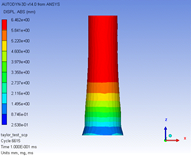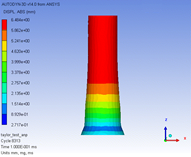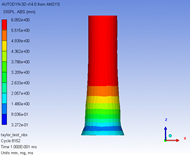Clicking the Solvers button in the Parts panel displays the following dialog for unstructured Solid Parts in the lower region of the panel :

- Hex Integration
The unstructured, 8 noded, constant strain, hexahedral element is available in two forms.
Finite volume formulation with exact volume integration (Wilkins 1974) (Default)
Finite element formulation using approximate Gaussian quadrature (Hallquist 1976)
The finite volume formulation is the default option and recommended for most applications involving large deformation or warped meshes. This formulation is the same as that used in the Structured (IJK) Lagrange solver.
The finite element formulation is included as a solver option and provides efficiency improvements over the above. However, the accuracy of the element is reduced for warped elements.

Example performance comparison for the three Hex solvers now available in Autodyn.
- Hex Hourglass Control
Hourglass control for the Unstructured Hex solvers is provided in two forms:
AD standard
Flanagan-Belytschko.
The "AD Standard" option is the default option and works well for most applications. This is the most efficient option in terms of memory and speed. A default viscous damping coefficient of 0.1 is recommended.
The "Flanagan-Belytschko" form of hourglass control is available as an option since the AD standard form may not perform well under large rigid body rotations. The Flanagan-Belytschko form of hourglass control is invariant under rotation hence overcomes this problem. Both viscous and stiffness based control is available. The default is stiffness based control with a coefficient of 0.1.
- Tet Pressure Interaction
The Unstructured Tetrahedral element is available in three forms:
Standard constant pressure (SCP) Tet
Average nodal pressure (ANP) Tet, (Burton 1996).
Nodal Based Strain (NBS) Tet, (Bonet et al., 2001)
The SCP tetrahedral element is a basic, constant strain element and can be used with all the standard Autodyn material models including erosion. Explosive burn logic is also available. The element is intended as a "filler" element in meshes dominated by hexahedral elements. The element is known to exhibit locking behavior under both bending and constant volumetric straining (that is, plastic flow). If possible the element should therefore not be used in such cases.
The ANP tetrahedral element is an extension of the advanced tetrahedral element (Burton 1996) and can be used as a majority element in the mesh. The ANP tetrahedral overcomes problems of volumetric locking, which occur with the SCP tetrahedral element. However, the ANP tetrahedral element is still susceptible to shear locking in bending dominated problems. You should therefore be careful to verify their results in such cases.
For meshes containing a majority of tetrahedral elements, the ANP option is recommended.
Material Modeling Options Available with ANP-Tet Elements
Equations of State Strength Models Failure Models Linear Elastic Hydro (Pmin) Polynomial Viscoelastic Plastic Strain Shock Von Mises Principal Stress Porous Johnson Cook Principal Stress Compaction Piecewise JC Principal Stress P alpha Zerilli Armstrong Johnson-Holmquist Rigid Steinberg Guinan RHT Concrete Hyperelastic Drucker-Prager Grady Spall Model Johnson-Holmquist Johnson Cook RHT Concrete Crack Softening MO Granular Hyperelastic Parts containing ANP tetrahedral elements should only be filled with a single material. Multiple materials can be represented in a single body by creating multiple parts and joining them together.
The NBS tetrahedral element (Bonet et al., 2001) is a further extension of the ANP tetrahedral element in that the entire solution is calculated on the nodes rather than just the pressure. The NBS tetrahedral element has the advantage over the other two tetrahedral formulations as it overcomes both volumetric and shear locking.
Supported material types in the NBS tetrahedral element are currently limited to ductile materials. The full list of supported material models can be found in the table below.
Table 10.1: Material Modeling Options Available with NBS-Tet Elements
Equations of State Strength Models Failure Models Linear
Elastic
Hydro (Pmin)
Polynomial
Von Mises
Plastic Strain
Rigid
Johnson Cook
Principal Stress
Shock
Piecewise Johnson Cook
Principal Strain
Zerilli Armstrong
Principal Stress/Principal Strain
Cowper Symonds
Johnson-Holmquist
Bilinear Hardening (Isotropic only)
Grady Spall
Multilinear Hardening (Isotropic only)
Johnson Cook
Steinberg Guinan
Stochastic Failure
If a model containing NBS tetrahedral elements exhibits zero-energy modes (Puso, 2006), the PUSO stability coefficient can be set to a non-zero value. The recommended value is 0.1. Stabilization is achieved by taking a contribution to the nodal stresses from the SCP solution. Therefore, for models with a non-zero Puso stability coefficient, the solution is computed on both the nodes and the elements. Both can be visualized as contour plots: the standard variables show a volume-weighted nodal average in the elements, and the SCP solution used to stabilize for non-zero Puso coefficients can be plotted using the variables with suffix '.NBS'.
NBS tetrahedral elements cannot share nodes with ANP tetrahedral elements, SCP tetrahedral elements, shell elements or beam elements. Also note that the use of NBS tetrahedral elements with joins or spotwelds is not supported.
Note that a hexahedral mesh will generally provide more efficient results than a tetrahedral mesh hence we only recommend the use of predominantly tetrahedral mesh models for convenience of mesh generation.
Tet-SCP Tet-ANP Tet-NBS 


Comparison of results of a Taylor test solved using SCP, ANP and NBS Tetrahedral elements. Results using NBS and ANP tetrahedral elements compare more favorably with experimental results.

Comparison of the performance of SCP (1), ANP (2), NBS tetrahedral (3), and hex (4) elements in a bending dominated problem. The displacement of the beam with NBS tetrahedral elements is the most similar to the beam meshed with hexahedral elements as it does not exhibit shear locking as is seen in the beams solved using SCP and ANP tetrahedral elements.
Burton A.J., "Explicit, Large Strain, Dynamic Finite Element Analysis with Applications to Human Body Impact Problems", PhD Thesis, University of Wales, December 1996.
Bonet J, Burton A.J. "A simple averaged nodal pressure tetrahedral element for incompressible and nearly incompressible dynamic explicit applications". Communications in Numerical Methods in Engineering 1998; 14, 437-449.
Bonet J., Marriott H., Hassan O. “An averaged nodal deformation gradient linear tetrahedral element for large strain explicit dynamics applications”. Communications in Numerical Methods in Engineering 2001; 17, 551-561.
Puso M. A.,Solberg J. “A stabilized nodally integrated tetrahedral”. International Journal for Numerical Methods in Engineering 2006; 67, 841-867.


